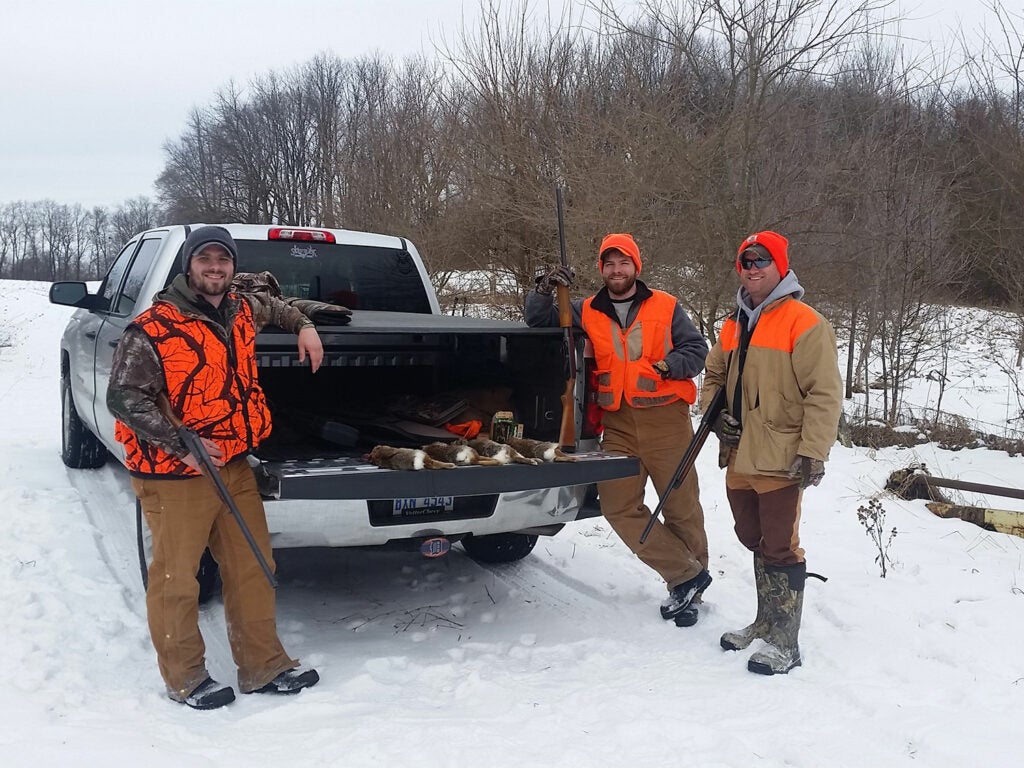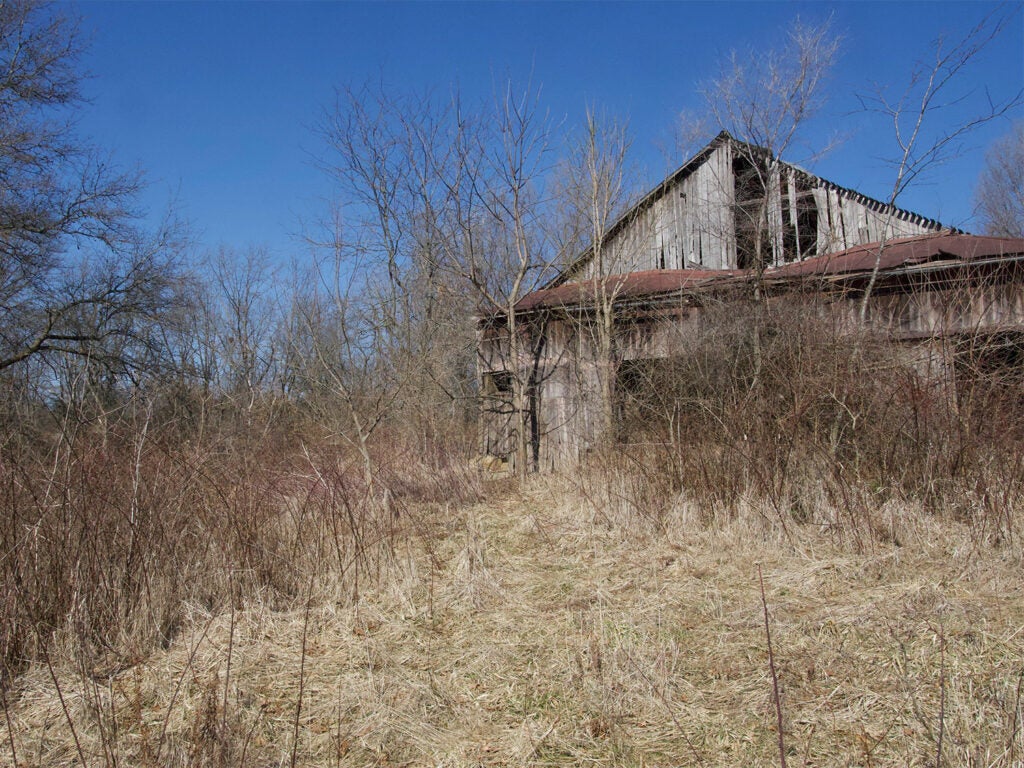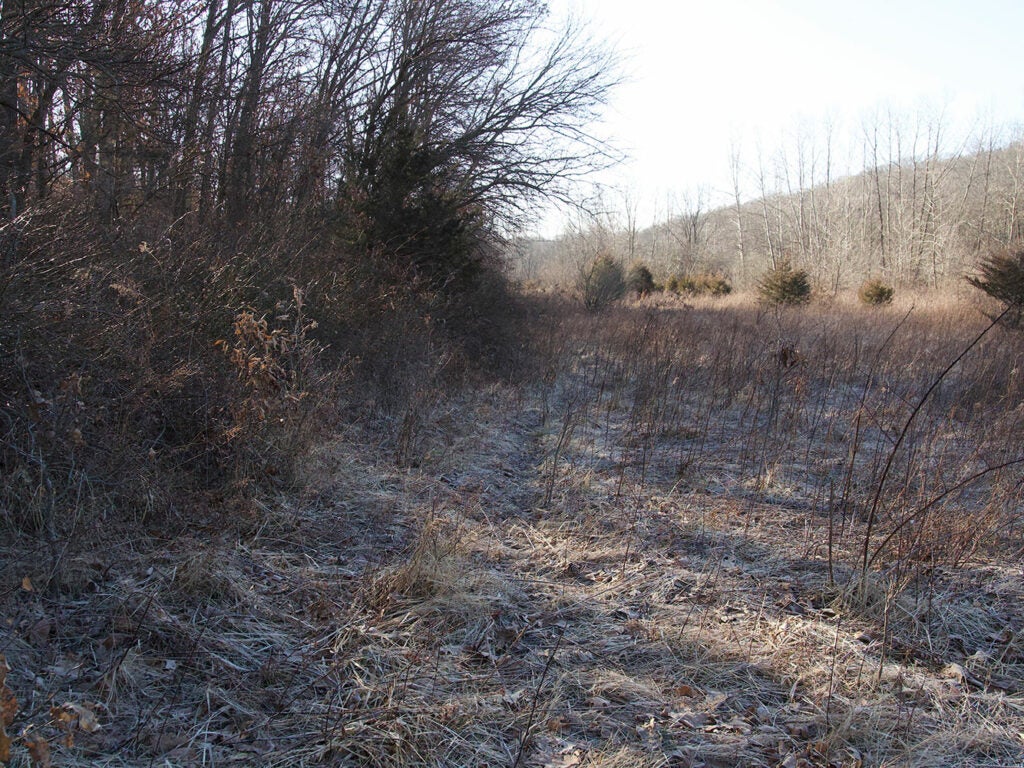A group of rabbit hunters. Alex Gyllstrom
Close your eyes and picture your ideal rabbit hunting habitat. Chances are it’s some variation of overgrown brush piles, thick tangles of briars, or brushy fence rows bordering an ag field. No question these are incredible places to find a day’s limit of cottontails, but some true rabbit goldmines are right under your nose. There the kinds of places you probably walk by every day without so much as a second glance. I know I did before the rabbit lightbulb finally turned on. To help fill the stew pot after deer season is over, add a few of these unusual and overlooked places to your rabbit hunting arsenal. Here’s where to hunt rabbits when all the traditional spots have already been picked over.
Junkyards

The author and two hunting buddies after a successful junkyard hunt. Alex Gyllstrom
At first glance junkyards look, well … junky. They’re not much more than cars, farm equipment, stacks of steel, and piles of old stuff left and forgotten. But they can be a rabbit’s Taj Mahal. To a rabbit, an old car body provides excellent shelter from wind, snow, and rain and gives shade during the summer. Grass and vegetation grow up around the frame providing food and material for dens, and because old cars are usually parked side-by-side, rabbits can easily flee from danger. Next time you’re strolling by on a hunt, give that old bumper a kick and it just might surprise you what comes springing out.
How to Hunt a Junkyard
Whether it’s a pile of random debris, a broken down manure spreader, or old refrigerator, I approach a junkyard in a similar way to a brush pile. Whatever object you’re checking, determine the most likely exit route and approach from the opposite end. If you’re hunting with a buddy or in a small group, make sure you’re a safe distance apart and approach at a slight angle. The goal is for each hunter to be able to cover an area of escape. Keep an eye out for rabbits flushing ahead of you, they may not run far especially if there are plenty of piles for cover.
Abandoned Homesteads and Dilapidated Barns

Dilapidated barn foundations are the perfect places to look for cottontails. Alex Gyllstrom
When I first started hunting rabbits, it took me a few years to realize the value of an abandoned, overgrown homestead. I suppose it had something to do with my father drilling into my head to stay away from buildings and houses while hunting with a gun. Although he was right about trespassing, once you have permission and can confirm a homestead or barnyard is uninhabited, have at it. Rabbits will dig dens around the foundations of these deteriorating structures. Often in the space around the foundation or what’s left of it, there are old pieces of farm equipment, rolls of fence, and other objects taken over by grass and woody vegetation. Rabbits thrive on this kind of cover for food and shelter. Check every piece of metal, fence, or log pile regardless of its size. They are awesome little pockets to catch rabbits hiding away from their holes, especially on nice, sunny days.
How to Hunt an Abandoned Homestead
If the area holds rabbits, there’s a good chance they will be using what’s left of the structure as a windbreak, so I approach from downwind and concentrate on the thickest cover first. I work my way up to the foundation or pile of debris, slowly watching for slight movement or any indication of preferred travel routes. If it’s an isolated pile such as a roll of fence or stack of old tires, I work my way straight at it from the side least likely to offer an escape route. By approaching cover this way, I give myself shooting opportunities on both sides and directly in front of me. Similarly to hunting in junkyards, if you flush a rabbit and don’t get a shot or miss, wait and watch. It’s not uncommon for a rabbit to run a short distance and stop at another source of shelter or even make a large circle in an attempt to return to its original hiding location.
Powerlines

The edge of a powerline cut offers rabbits cover and food. Alex Gyllstrom
I love hunting the clear-cut areas under powerline openings, especially ones that have only been half-heartedly taken care of. It’s amazing what some sunshine and a little rain can do around the two-year mark after it’s been cut. Thick, gnarly, waist tall briars and woody vegetation sprout up and act as a flashing vacancy sign for rabbits. Powerlines can make for ideal conditions to run a beagle or two as well. With somewhat defined edges, rabbits love to hunker down on the transition of the thick stuff and open woods or a newly cut lane under the lines. You or a small group can walk those edges kicking up anything on the outside while the dog runs the thick center, flushing rabbits into your path. A freshly cleared powerline can still be worth your time, too. The exposed stems and roots provide attractive food for rabbits while thicker edges provide good cover.
How to Hunt a Powerline Cut
In my hunting circle, we don’t usually hunt rabbits with dogs. So we have names for positions when we’re strategically working an area. This works especially well when we hunt powerlines. The hunters on the wings or perimeters of the thicker cover are known as shooters and the one or two hunters working the thick, rough middle section are, ironically known as the dogs. I prefer being the dog and always have. There’s more to be learned about how rabbits navigate and utilize cover and usually this position results in as many, if not more, shot opportunities. When navigating these wider, thick areas or transition lines, be sure to look behind you frequently. It’s common for rabbits to slip by you right out the back door and you’ll never know they were even there.
How to Find Rabbit Hunting Spots
Digital mapping tools like OnX or HuntStand can help you identify prime rabbit territory before you ever leave home. First do some e-scouting by finding public land in the region you want to hunt. Once you’ve identified accessible lands, zoom in and search for the brushy habitat that rabbits love. Overgrown fence lines, cattail ditches, and brushy creek bottoms can all be identified with satellite imagery. Once you’ve got a handful of spots located through e-scouting, then it’s time to put boots on the ground and do some exploring. Hunt your way through each spot looking for rabbit sign. Spend more time in areas where you see lots of sign, and cruise through areas were sign is minimal or where it seems like there’s lots of hunting pressure. With some trial and error, you’ll soon find several rabbit hunting hotspots that will produce year after year.
The post Where to Hunt Rabbits: 3 Overlooked Hot Spots appeared first on Outdoor Life.
Articles may contain affiliate links which enable us to share in the revenue of any purchases made.
By: Alex Gyllstrom
Title: Where to Hunt Rabbits: 3 Overlooked Hot Spots
Sourced From: www.outdoorlife.com/story/hunting/overlooked-rabbit-hunting-hot-spots/
Published Date: Thu, 12 Mar 2020 20:47:55 +0000
----------------------------------------------
 Backyard GrillingWeekend WarriorsAdvice from DadBeard GroomingTV Shows for Guys4x4 Off-Road CarsMens FashionSports NewsAncient Archeology World NewsPrivacy PolicyTerms And Conditions
Backyard GrillingWeekend WarriorsAdvice from DadBeard GroomingTV Shows for Guys4x4 Off-Road CarsMens FashionSports NewsAncient Archeology World NewsPrivacy PolicyTerms And Conditions
